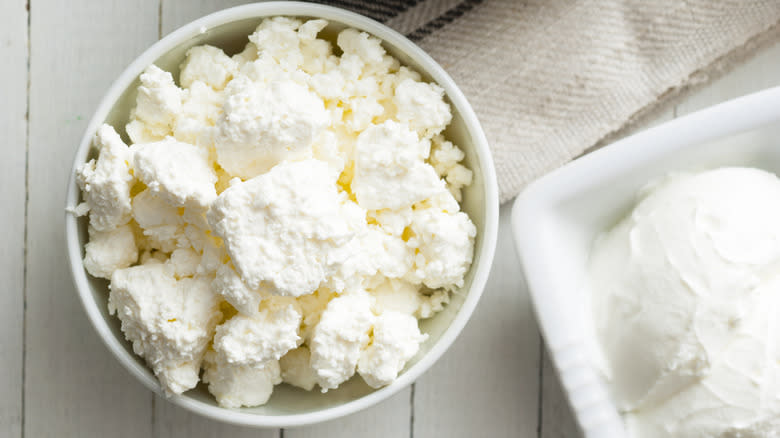Pat Ricotta With A Paper Towel To Prevent A Runny Lasagna

Classic lasagna, with its layers of pasta, rich sauce, and creamy cheese, is a comforting favorite loved by many. However, there's a common issue that can plague even the most seasoned cooks: A soupy lasagna. While it may seem elusive, achieving a lasagna that's not overly wet is entirely within reach. The hidden culprit behind lasagna soupiness may well be ricotta, which is a common addition both in the U.S. and in the south of Italy. Fortunately, there is a secret to keeping a lasagna with ricotta perfectly layered.
Several factors can contribute to a lasagna recipe turning out excessively wet. These include noodles that haven't been dried enough, watery vegetables or sloppy meat sauce, and the often-overlooked culprit -- ricotta cheese. Ricotta cheese, with its creamy texture and mild flavor, is a quintessential ingredient in many lasagna recipes. However, it can also introduce excess moisture if not handled properly. To avoid a runny mess, it's crucial to pat dry the ricotta before incorporating it into your lasagna.
Once your ricotta is sufficiently dry, you can confidently incorporate it into your lasagna without worrying about it turning too watery. The result should be a beautifully layered lasagna with just the right amount of moisture, where each bite is a symphony of flavors and textures.
Read more: 13 Unexpected Ingredients To Elevate Lasagna
Tips For Drying Ricotta Well Before Layering Lasagna

Start with a good-quality ricotta cheese. Look for one that's less watery to begin with, as this will make the drying process easier. If there's visible liquid sitting on top of the ricotta in the container, carefully drain it off. You can do this by tilting the container slightly and using a spoon to scoop away the liquid.
Place a few layers of paper towels on a plate or a clean kitchen towel. The towels will absorb any moisture from the ricotta. Scoop the ricotta onto the paper towels, spreading it out in an even layer. This allows the towels to come into contact with as much surface area as possible. Gently pat the ricotta with additional paper towels to absorb any moisture on the surface. Be careful not to press too hard, as you don't want to remove the cheese's creaminess. Give the towels time to wick away any excess moisture.
Drying your ricotta chees is a small step that can have a big impact on the outcome of your lasagna, ensuring that it's a non-soupy delight that everyone will savor. But if you're still worried, make sure to read our Tasting Table tips on how to avoid other mistakes when making lasagna, too.
Read the original article on Tasting Table.

 Yahoo Sports
Yahoo Sports 
